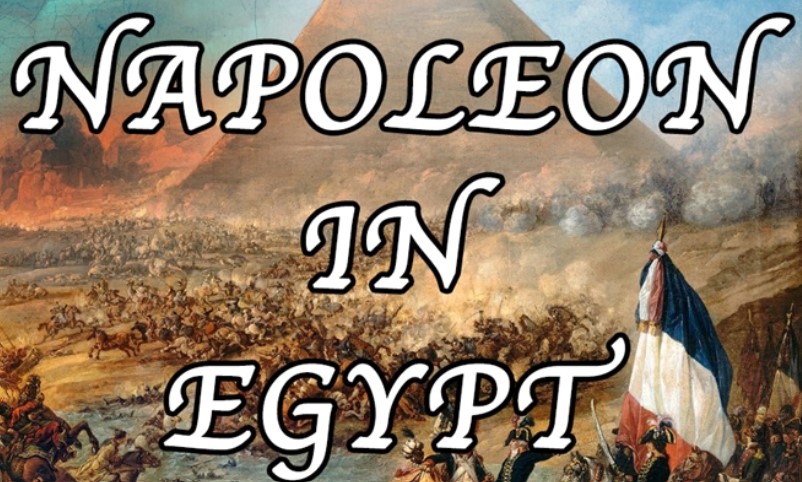We are familiar with some of Pascal Toupy’s work in a few games. We both have played, and really enjoyed, Saigon ’75 from Nuts! Publishing and Alexander has played a few of his solo games in Firebase Vietnam found in C3i Magazine #34 from RBM Studio and Roman Disaster at Teutoburg found in C3i Magazine #35. He is a good designer who has put out several good designs. When I heard that he was doing a game with GMT Games, and that it was based on Napoleon’s campaigns in Egypt, I was immediately interested. After seeing the game released on P500, I reached out to Pascal to see if he would share some background information on the design and he was more than willing to do so.
*Please keep in mind that the artwork and layout of the various components shown in this interview are not yet finalized and are only for playtest purposes at this point. Also, as this game is still in development, card and rules details may still change prior to publication.

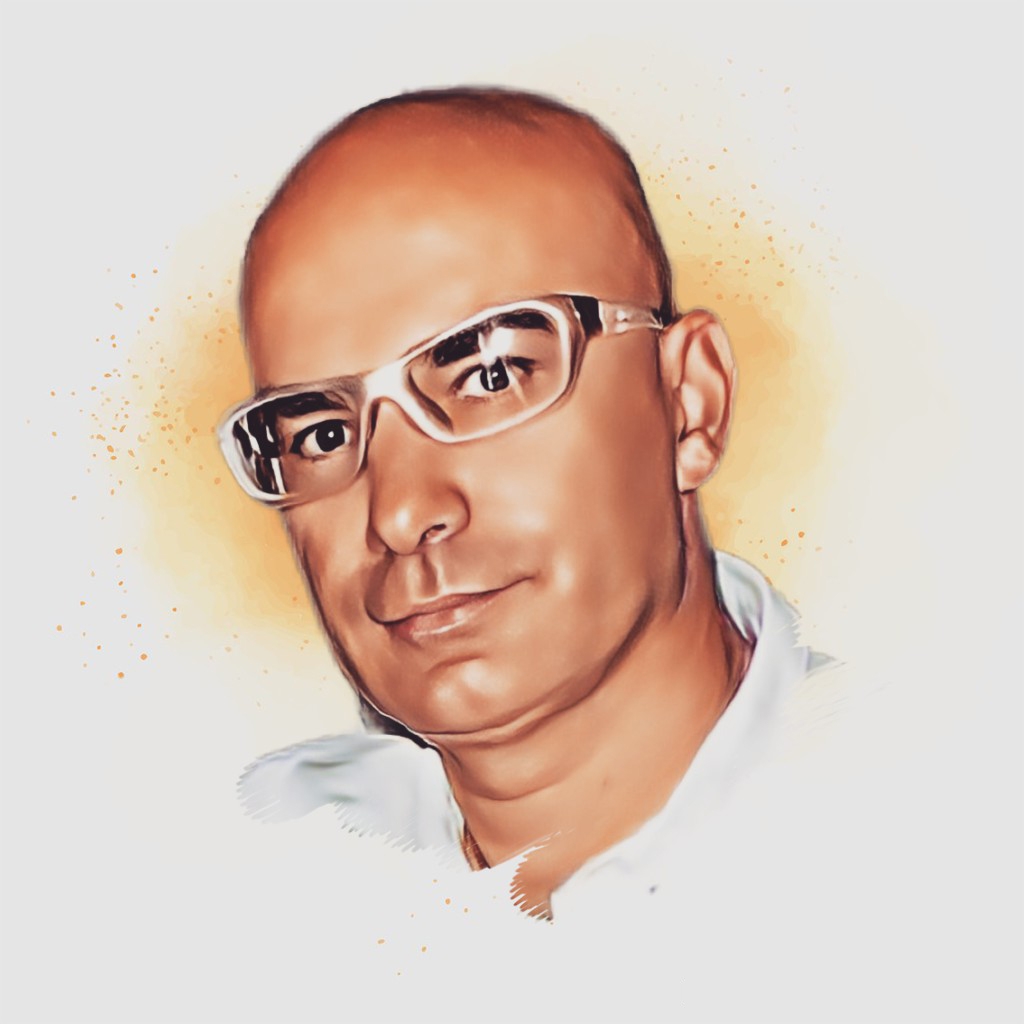
Grant: First off Pascal please tell us a little about yourself. What are your hobbies? What’s your day job?
Pascal: Hi Grant, Hi Alexander, thanks for having me. I’m a professional musician and my hobbies are playing wargames and hiking with friends and family.
Grant: What motivated you to break into game design?
Pascal: When I was a child, I used to create rules for my Airfix armies. Then one day I discovered that others were doing the same, and much better! And then, with regular wargame practice, I wanted to play in non-simulated periods. I also wanted to depict on the board and in my own way the actions I would encounter in my readings. That’s why I took a pen and wrote down the way I saw these things.

Grant: What historical period does your new design Napoleon in Egypt cover?
Pascal: It’s all about the French campaign in Egypt and Syria from 1798–1801, which was led by Napoleon Bonaparte. On July 1st, 1798, 35,000 French soldiers landed in Alexandria. This expeditionary force’s mission was many-fold: to find an alternative spice route through a foreseen Suez Canal, to settle yet another score with the British, to enlighten the population with ideals stemming from the recent French Revolution, and to discover what marvels and riches this fabled land of the 1001 Nights might hold. This was indeed an expedition where scientists walked alongside soldiers.
Grant: Why was this a subject that drew your interest?
Pascal: While my son Tom was researching for his thesis in History (Executioners and Victims of the Reign of Terror in Bordeaux, 1789-1815), he regularly drew my attention to the incredible destinies of young men from this period. Many of them would fight on the battlefields of Napoleon’s empire, and their first great adventure with Bonaparte was in Egypt. And that was the actual subject of the book I was reading at the same moment. We knew all about these events, of course, but the more we delved into the details, the more fascinated we became. We wanted to share this story with as many people as possible. Instead of writing a book, we created a card-driven game that allows the whole story to be told on the board and through the cards.
Grant: What research did you do to get the details correct? What one must read source would you recommend?
Pascal: We are fortunate to have many first-hand accounts of the expedition. Numerous books are online on the Bibliothèque Nationale de France website, and they are an incredible source of information. What’s really interesting is that they cover the human, military and scientific sides of the expedition. We will provide a complete bibliography in the game’s playbook.
Grant: What is the scale of the design? Force structure of the units?
Pascal: The game covers the entire campaign at the strategic level. The French army is pitted against the Mamluk and Ottoman armies supported by the British. Each French strength point is equal to 1,000 men, 5,000 for the Allies (Mamluks+Ottomans+British).
Grant: Why did you feel that the Card Driven Game mechanic was most suited for your vision?
Pascal: As explained above, the Card Driven Game format makes it possible to introduce a wealth of historical elements into the course of the game. In fact, players will be able to find the explanation and historical context of each card in the playbook.

Grant: What is the La Patrie en Danger Track and how does it work with the CDG focus?
Pascal: La Patrie en Danger (“The country (fatherland) in danger”) was the start of a declaration by the French Assembly on 11 July 1792 in response to Prussia joining Austria against France. It will be followed the next year by the Levée en Masse. This track is a mechanic identical to Twilight Struggle’s Space Race Track. You’re happy to be able to discard there an event favorable to your opponent, which could be very detrimental to your plan if they are allowed to gain the benefit of the event through you playin t he card.
Grant: How many cards are included in the game deck? How did you determine the appropriate number?
Pascal: We’ve got 102 cards in the deck, and we’d love to have many more to describe all the incredible stories that unfolded during this extraordinary adventure. But we had to remain reasonable, and our deck has always hovered around 100 cards. This is a part of the design that is always hard to pare down but you have to keep it manageable so that there is a chance that cards come back around as the deck is played through.
Grant: How do you go about balancing the events?
Pascal: Events can be neutral, favorable to the French or favorable to the Allies. So you have to balance everything out. Of course, there’s a mathematical side to finding the right balance, but above all we have to thank our playtesters who have played (and are still playing) dozens of games and have helped fine tune the whole game. Designers can make changes to cards but until they are played with through testing, the result will be hard to determine.
Grant: Can you share a few examples of cards and explain how they work?
Pascal: Depending on the card he is playing, a player can choose from the following options: playing a card as an Event or a Reaction Event and playing a card for Action Points.
A player may play a card as an Event if it is neutral or associated with their faction AND the card’s prerequisite, if any, is met. After being played as an Event, a card is either discarded, placed next to the board if it has a Lapsing indicator or removed from the game if it bears the Remove from play indicator. Some cards are labeled as Reaction Events, meaning they can be played outside the normal sequence of play of the Action Phase, if and when a player so chooses. Of course each such
card will have a prerequisite that will detail the exact timing allowing the play of its Event.
Any card, including a card associated with the opposing faction, may be played for AP during an Impulse. When played for AP, a card yields a number of AP equal to its AP value. These AP are then spent to perform one or more actions. If the Active Player plays a non-Reaction card associated with the opposing faction for its AP, the Event will occur if its prerequisite is met. The Active Player decides whether the Event occurs before or after they spend the AP. During the Event implementation, the Non-Active Player makes all necessary decisions of course. I also have to mention that as soon as a card with a Bonus Espionage Point symbol is played for the AP or the Event, the Active Player gains 1 EP. Here below are examples of cards: All art is prototype version and absolutely not final.
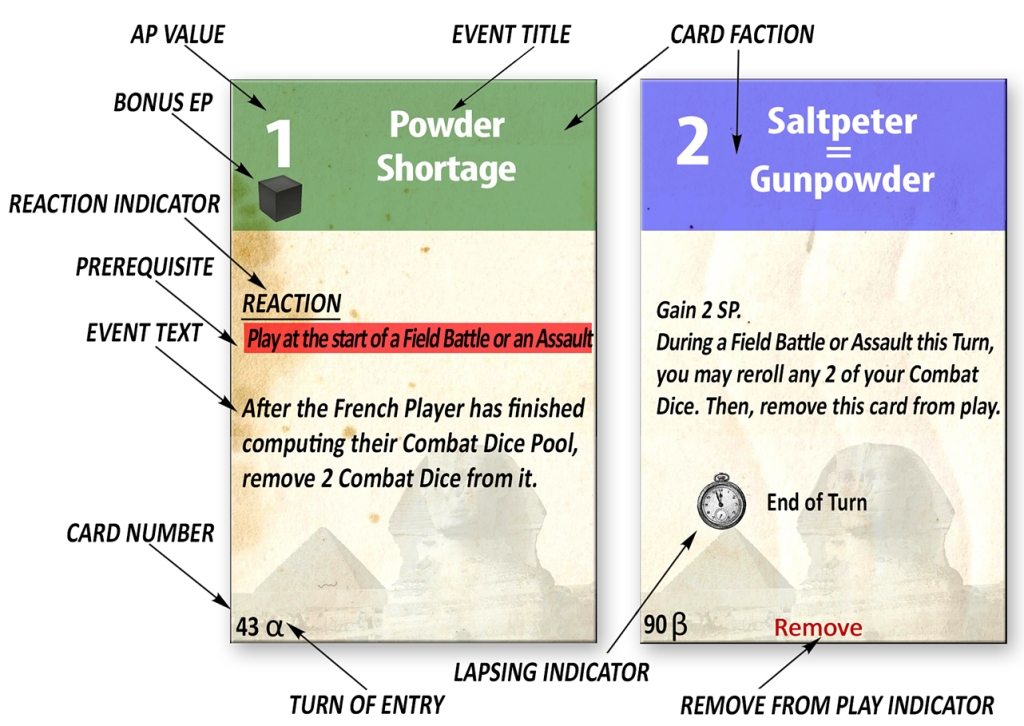
Grant: What can the players use Action Points to do?
Pascal: Any card, including a card associated with the opposing faction, may be played for Action Points during an Impulse. When played for AP, a card yields a number of AP equal to its AP value. These AP are then spent to perform one or more of the actions listed below:
● Shift a Fortified Space’s Public Order
● Recruit Units
● Move Formations
● Assault a Besieged Space
● Perform a Sortie
● Perform Naval Transport
● Gain Espionage Points
● Perform an Espionage action
● Gain Scientific Points (French Player only)
Grant: What is the purpose of each faction’s Home Card? Can you share the details of these cards?
Pascal: Players familiar with the Here I Stand Home Cards will feel at home here! Each player has a Home Card which is not part of their hand, and which is turned on its Available side at the beginning of each Turn. They are powerful cards! During their Impulse (or during a combat for the French player if played as a Reaction Event), if their Home Card is on its Available side, a player can play it for its AP or its Event. Their Home Card is then flipped over to its Unavailable side to indicate that it is no longer playable for that turn. While the Allies Home Card provides new units or helps them to obtain Naval Supremacy, the French Home Card has two options which reflect their superiority in battle or the work done by their scientists and administration to conquer hearts and minds (see below). All art is prototype version and absolutely not final.
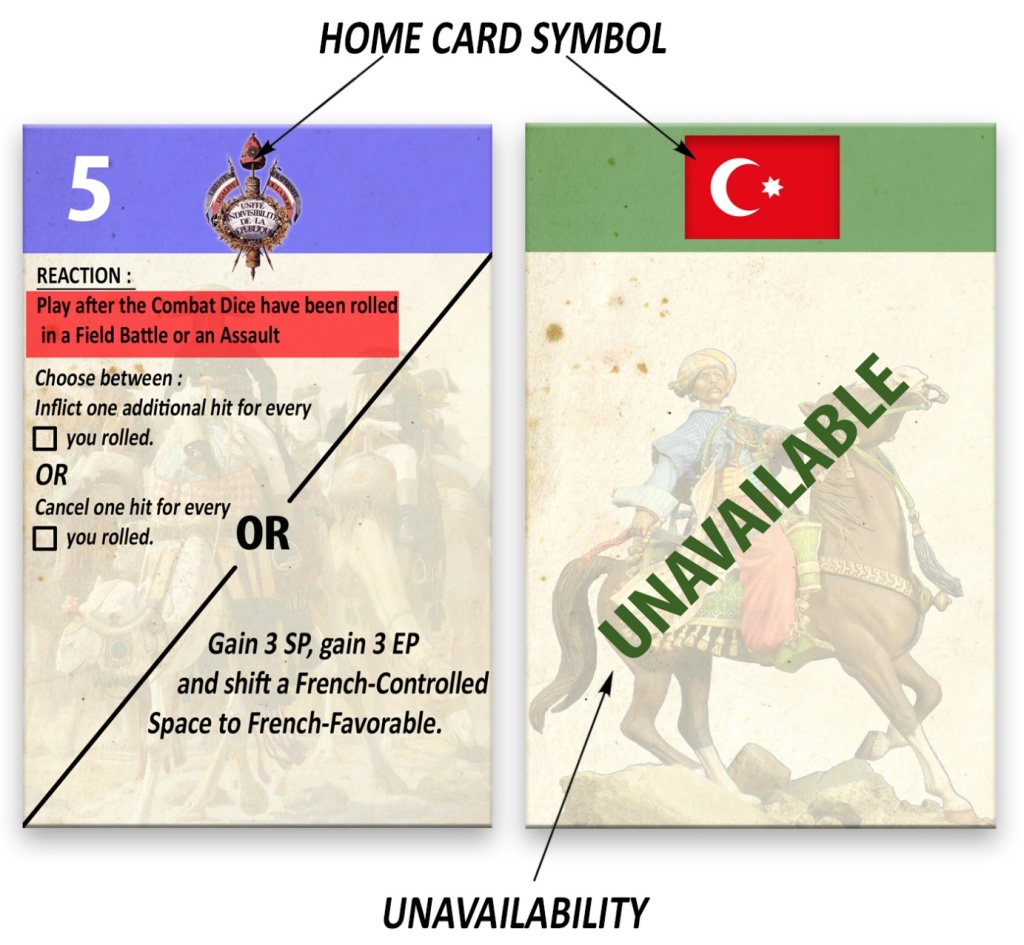
Grant: What area does the game board focus on?
Pascal: The playing area covers the whole of Egypt, from the Nile delta to Thebes, and the Middle East from Cairo to Damascus, not forgetting the key islands of Malta and Cyprus.

Grant: Why was a Point to Point movement map your chosen medium?
Pascal: The point-to-point system speeds up the game and is easy to use, even for novice players. It also creates some really interesting pinch points on the board and causes players to have to think about their turns and how they are going to utilize their AP to get where it is that they need to go.
Grant: What strategic considerations and choke points does the layout present?
Pascal: It’s an immense territory dotted with desert zones and and other inhospitable areas. Control of both the Nile and the seas is key to the movement of troops and the successful execution of any plan. But wherever you are in these vast lands, you’re never safe from ambush.
Grant: How does combat work in the design?
Pascal: Following all possible Interception and Avoid Battle attempts as well as the option for
the Non-Active Player to Withdraw his Units Behind Fortifications a Field Battle occurs if Units from both Factions coexist in an Unbesieged Space. The Attacker selects a General and a Formation. The number of units in that Formation cannot be bigger than this General’s Strategy Rating. The Defender does the same. If there is no General a maximum of four Units may be part of the Formation. Each player, Attacker first, may play any number of Reaction Events in response to the start of a Field Battle.
Then the Attacker computes their Combat Dice Pool which consists of 1 die for each Unit in the Attacking Formation plus x additional dice, where x is the Battle Rating of the Attacking General. The Defender does the same. Please note that the color of these dice depend on the Combat Quality of each Unit. All Combat Dice are then rolled simultaneously. Each result of a target scores a hit on the Enemy Units. If the Formation rolling the dice includes a General, each result of a square also scores a hit on the Enemy Units. The faction that scored the most hits wins the Field Battle. If the
number of hits scored was the same, the Defender wins the Field Battle. Finally, each player, Attacker first, eliminates one Unit from the Field Battle Space for each hit scored by their opponent. This is a pretty straight forward, simple and quick battle resolution system that speeds the combat procedure but keeps all the battle’s tactical aspect.
Grant: What are the different special dice types?
Pascal: As explained above, we have favored a simple and fast combat system that does not require the players to calculate dice roll modifiers or refer to tables. There are four special dice types in Napoleon in Egypt, each associated with a combat quality ranging from Elite to Mediocre. Each type of dice is different and contains blank faces (failures), targets (successes) or squares (which can be treated as successes if a general is leading the troops). The players roll the dice corresponding to the number of their units engaged and total the number of successes. See below the dice breakdown.
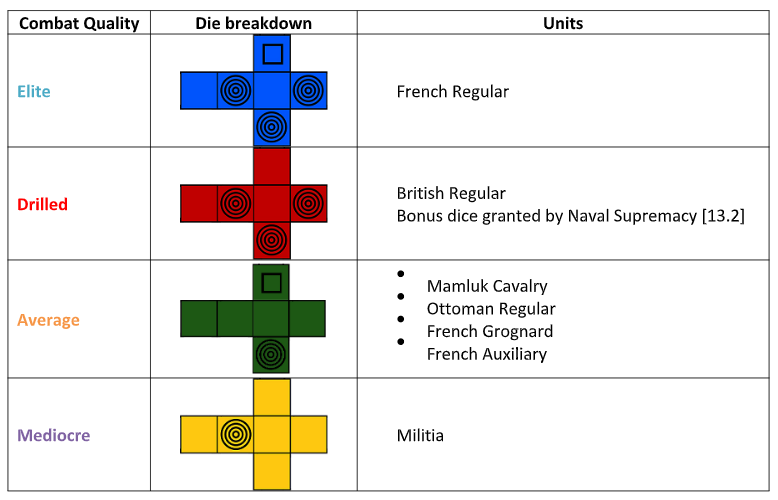
Grant: What role does science play in the campaign? Why was this important to model?
Pascal: The scientific aspect of the campaign is very important in the game. 166 scientists
participated in the expedition. The spread of Enlightenment ideas and the social emancipation of peoples (thanks in particular to scientific progress) were very important to the young Bonaparte and the French Revolution. And let’s not forget that France was also aiming to dig a “Suez Canal” in order to beat the British Empire on trade.
Grant: How do players measure the progress of the expedition’s scientists and the benefits brought to the field?
Pascal: The French player will have to develop the scientific aspect in order to facilitate the victory. Tracks are used to measure the progress of the expedition’s scientists and the benefits brought to the field. In particular, he’ll have to build a hospital to care for his grognards, as he won’t be able to count on any reinforcements.
Grant: How does the design focus on the conquest of the hearts and minds of the population?
Pascal: It is a very important element of the game. Bonaparte and his generals understood this very well as they learned to speak the local language or relied on local dignitaries to push through their reforms…and raise taxes! Indeed, the local populations take sides with one camp or the other providing militias or support.
Grant: Why is a good spy network needed? How do players build this?
Pascal: Changes of allegiance are frequent in the land of a thousand and one nights! For this reason, a good spy network will be a real advantage (or bane!). It will allow players to to set up ambushes or to create public order disturbances. You will have to know how to make your spies act at the right time, while keeping some in reserve to counter those of your opponent. Each player will have a number of black cubes called Espionage Points (EP) that can be used to perform Espionage and Counter-Espionage actions as well as for Backing Riots. There are several ways for players to gain EP.
- The Active Player may spend 1 AP to gain 1 EP.
- Players may start some scenarios with a number of EP, as specified in the scenario setup.
- Some cards have the Bonus EP icon and will grant the Active Player 1 EP when they are played for the AP or the Event.
- Some spaces of the La Patrie en Danger Track allow players to gain EP.
- Some Repression results grant EP to the Allied Player.
- The French Player gains EP when reaching the rightmost space of a Science Level.
Grant: What are the different factions included? How do they differ?
Pascal: In Napoleon in Egypt, a French player faces an Allied player, controlling the Mamluk/Ottoman/British coalition. At the beginning of the campaign, the French seem unstoppable because everything is in their favor: number and quality of troops, element of surprise, better command, etc. But the French regulars, as strong as they are in battle, are limited in number. The French must care for their wounded, convince the local population that they will be better off under French occupation, and devote time and effort to the expedition’s scientific mission. While the Ottomans have impressive human reserves, they have to rely on the discipline of their British allies if they were to prevail. The Mamluks are an important auxiliary force, but beware: they can sometimes change sides!
Grant: How is victory achieved?
Pascal: Players win by accumulating Victory Points. There are several ways players can score VP. Each controlled Fortified Space is worth 1 VP (Minor Cities) or 2 VP (Major Cities and Fortresses). Players also have to pay ransoms in VPs to recover their Captured Generals! The French player also score VP’s when achieving scientific goals. And finally some key Events allow players to score VP.

Grant: What different scenarios are included?
Pascal: Napoleon in Egypt comes with four scenarios. The campaign game can be played in 4 to 5 hours, and let the players relive the highs and lows of the French expedition, from its landing to its bitter capitulation. The three shorter scenarios (which each can be played in 90 minutes when you are familiar with the system), cover different periods of the campaign which vary a lot in situations and challenges. The first scenario (The Conquest) sees the French surprise the Mamluks and sweep across Egypt. In the second scenario (The Syrian Anabasis), Napoleon Bonaparte rushes on the road to Damascus to take control of the key city and port of Acre. The third scenario (The Fall) sees the Ottomans and Mamluks supported by the British counterattacking, while Bonaparte might leave Egypt and let Menou take care of what’s left. Napoleon in Egypt also comes with a GMT One solitaire module which allows the player to see the campaign evolving while taking all the decisions.
Grant: What type of experience does the game create?
Pascal: The game is simple and fast-paced, yet the players are faced with major challenges. They are involved at every moment, and must focus on their faction’s advantages to achieve victory.
Grant: What are some general strategies for the various factions?
Pascal: As Bonaparte did in 1798, the French player must strike fast and hard to conquer Egypt as quickly as possible. Once that’s done, he must begin a long march eastwards, trying not to lose too many forces en route, in order to deliver a fatal blow to the Ottoman armies. Of course, he mustn’t forget to let the ideas of the Revolution shine through and conquer hearts and minds! For his part, the Allied player must not panic in the face of such military genius. He knows that the French will not receive reinforcements, and that their army is not eternal. He must meticulously prepare his
counter-attacks, ensure naval supremacy and ambush the French columns when possible.
Grant: What are you most pleased about with the design?
Pascal: I like games that tell a story and allow you to have fun without spending hours consulting complicated rules and tables. Napoleon in Egypt absolutely meets these criteria. Although very accessible, the system takes players on a challenging journey that will allow them to relive the events of the Egyptian campaign in one big evening. Each game tells an action-packed story.
Grant: What other designs are you working on?
Pascal: I have a lot of projects on my desk. But the one I’m working on in particular is a solitaire game that retraces the epic story of Pyrrhus, King of Epirus in the third century BC. It’s also a game I created with my son Tom, and we had a lot of fun in the process. The aim of the game is, of course, to expand the kingdom of Epirus by fulfilling Pyrrhus’ unfulfilled dream of dominating Rome. I’ve designed the system as an open world, meaning that you can play the game trying to achieve the
historical quest or without worrying about the historical stakes, and simply see to the survival of your people and your dynasty. That’s why we call it Dynasties: Pyrrhus.
Another of my games is due to be released very soon by Fellowship of Simulations called Vendée 93. It’s the second in the UP! Series (Under Pressure!) I created with my friend Jean-Philippe Barcus, the first game is Saigon ’75 (Nuts! Publishing). As the title suggests, the game retraces the actions and events of the War in the Vendée in 1793. It’s very interesting to see that many of the people who took part in this civil war in France will be later part of Bonaparte’s expedition to Egypt! We’re very pleased with the result, and feel we’ve further improved the system proposed in Saigon ’75. I can’t wait to see the game on the players’ table!

Thank you Pascal for your time in answering our questions. I am very much interested in this very engaging looking game and await further information on the game as it plows through design and playtesting. I also am very much looking forward to your other games as we loved Saigon ’75 and that system in other conflicts would be fantastic!
If you are interested in Napoleon in Egypt, you can pre-order a copy for $62.00 from the P500 game page on the GMT Games website at the following link: https://www.gmtgames.com/p-1004-napoleon-in-egypt.aspx
-Grant
